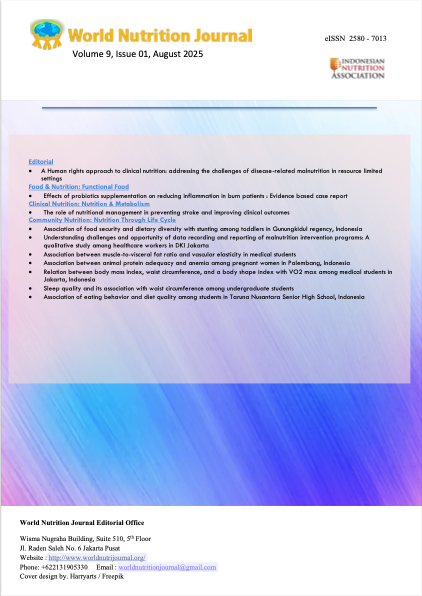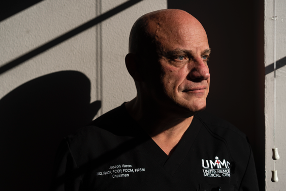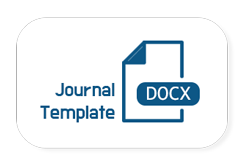Relation between body mass index, waist circumference, and a body shape index with VO2 max among medical students in Jakarta, Indonesia
Abstract
Background: Individuals with low VO2 max have higher potential of chronic disease in later life. Body fat composition is a factor that affects VO2 max. A sedentary lifestyle and poor diet in medical students can lead to excess body fat mass, which can be measured through BMI, WC, and ABSI. Objective: The study aimed to determine the relation between BMI, WC, ABSI, and VO2 max in medical students. Methods: This study used an observational analytic method and a cross-sectional approach. It was conducted at the Medical Education and Research Center UPNVJ from January to December 2024. The sampling technique was simple random sampling with total sample size of 46 respondents. Data collection involved filling out a questionnaire and measuring BMI, WC, ABSI, and VO2 max. Statistical analysis in this study was performed using the Mann-Whitney test. Results: Most respondents had normal BMI, normal WC, and low ABSI. The results of bivariate analysis showed relation between WC and VO2 max (p = 0.000), and there was no relation between VO2 max with BMI (p = 0.344) and ABSI (p = 0.956). Conclusion: The study's results conclude that WC and VO2 max are related. However, there was no relation between BMI and ABSI and VO2 max in medical students.Downloads
References
Sardjoko S. Pembangunan Gizi Indonesia. Jakarta: Kementerian PPN/Bappenas; 2019.
Kemenkes RI. Laporan Hasil Riset Kesehatan Dasar (Riskesdas) Indonesia Tahun 2013. Badan Penelitian dan Pengembangan Kesehatan, 2013; 2013.
Kemenkes RI. Laporan Hasil Riset Kesehatan Dasar (Riskesdas) Indonesia Tahun 2018. Badan Penelitian dan Pengembangan Kesehatan, 2018; 2018.
Kemenkes RI. Survei Kesehatan Indonesia (SKI) 2023 Dalam Angka [Internet]. Badan Kebijakan Pembangunan Kesehatan; 2023 [cited 2024 Nov 1]. Available from: https://www.kemkes.go.id/id/survei-kesehatan-indonesia-ski-2023
Guyton AC. HJE. Buku Ajar Fisiologi Kedokteran. 12th ed. Jakarta: EGC; 2014. 850 p.
Handoko A, Prasetyo A, Wulandari P, Sofiana KD, Firdaus J, Pertiwi KA. The Relationship Between Body Mass Index and Student Body Ability Index of Medical Faculty Jember University. J Agromedicine Med Sci. 2021 Oct 31;7(3):147.
Yuniah B, Feriandi Y, Yulianto FA. Proporsi Konsumsi Junk Food dan Status Gizi Berlebih di Mahasiswa Kedokteran. J Ris Kedokt [Internet]. 2023 Dec 15;69–74. Available from: https://journals.unisba.ac.id/index.php/JRK/article/view/2878
Nugraha AW, Sartono A, Handarsari E, Studi PD, Fakultas Ilmu Keperawatan dan Kesehatan G. Konsumsi Fast Food dan Kuantitas Tidur Sebagai Faktor Risiko Obesitas Siswa SMA Institut Indonesia Semarang [Internet]. Vol. 8. 2019. Available from: http://jurnal.unimus.ac.id
Febriyanti N, Adiputra I, Sutadarma I. Hubungan Indeks Massa Tubuh dan Aktivitas Fisik Terhadap Daya Tahan Kardiovaskular Pada Mahasiswa Fakultas Kedokteran Universitas Udayana. 2015.
Sumardiyono S, Pamungkasari EP, Mahendra AG, Utomo OS, Mahajana D, Cahyadi WR, et al. Hubungan Lingkar Pinggang dan Lingkar Panggul dengan Tekanan Darah pada Pasien Program Pengelolaan Penyakit Kronis (Prolanis). Smart Med J. 2018 Sep 18;1(1):26.
Winata BJ, Sidharta VM, Hananta L, Vetinly, Prastowo NA. Body Mass Index, a Body Shape Index, and Waist-to-Height Ratio in Predicting Elevated Blood Pressure. Althea Med J. 2022 Mar;9(1):19–23.
Fang H, Berg E, Cheng X, Shen W. How to best assess abdominal obesity. Curr Opin Clin Nutr Metab Care. 2018 Sep;21(5):360–5.
Harbuwono DS, Tahapary DL, Tarigan TJE, Yunir E. New proposed cut-off of waist circumference for central obesity as risk factor for diabetes mellitus: Evidence from the Indonesian Basic National Health Survey. PLoS One. 2020 Nov 18;15(11):e0242417.
Krakauer NY, Krakauer JC. Dynamic Association of Mortality Hazard with Body Shape. PLoS One. 2014 Feb 20;9(2):e88793.
Dhana K, Koolhas C, Schoufour J, Rivadeneira F, Hofman A, Kavousi M, et al. Association of anthropometric measures with fat and fat-free mass in the elderly: The Rotterdam study. Maturitas. 2016 Jun;88:96–100.
Zhou N. Assessment of aerobic exercise capacity in obesity, which expression of oxygen uptake is the best? Sport Med Heal Sci. 2021 Sep;3(3):138–47.
Maksum A, Kristiyanto A, Akbar R. Laporan Nasional Sport Development Index Tahun 2021: Olahraga Untuk Investasi Pembangunan Manusia [Internet]. 2022. Available from: https://www.researchgate.net/publication/359443662
Kisner C, Borstad J, Colby LA. Therapeutic Exercise: Foundations and Techniques. 8th ed. Philadelphia: F. A. Davis Company; 2023.
Harber MP, Kaminsky LA, Arena R, Blair SN, Franklin BA, Myers J, et al. Impact of Cardiorespiratory Fitness on All-Cause and Disease-Specific Mortality: Advances Since 2009. Prog Cardiovasc Dis. 2017 Jul;60(1):11–20.
Srivastava S, Tamrakar S, Nallathambi N, Vrindavanam SA, Prasad R, Kothari R. Assessment of Maximal Oxygen Uptake (VO2 Max) in Athletes and Nonathletes Assessed in Sports Physiology Laboratory. Cureus. 2024 May 26;
Buttar K, Saboo N, Kacker S. A review: Maximal oxygen uptake (VO2 max) and its estimation methods. Int J Phys Educ Sport Heal. 2019 Jan;24–32.
Nurhayati T, Goenawan H, Farenia R, Rasjad AS, Purba A. Korelasi Aktifitas Fisik dan Komposisi Tubuh dengan Daya Tahan Jantung Paru. J Ilmu Faal Olahraga. 2019;21(1).
Powell TA, Mysliwiec V, Brock MS, Morris MJ. OSA and cardiorespiratory fitness: a review. J Clin Sleep Med. 2022 Jan;18(1):279–88.
Casadei K, Kiel J. Anthropometric Measurement [Internet]. StatPearls [Internet]: StatPearls Publishing; 2022 [cited 2024 Mar 20]. Available from: https://www.ncbi.nlm.nih.gov/books/NBK537315/
Khairunnisa S, Fiana DN, Ismunandar H, Berawi KN. Hubungan Indeks Massa Tubuh terhadap Volume Oksigen Maksimal (VO2max) Mahasiswa Tingkat Pertama Fakultas Kedokteran Universitas Lampung. Med Prof J Lampung. 2023 Jan 26;13(1):28–34.
Vijaykumar N, P V, Jadhav S, K B, Badiger S. Influence of body fat, lean body mass, and body mass index levels on maximal oxygen consumption using submaximal exercise in young adults: An observational study. Natl J Physiol Pharm Pharmacol. 2021;(0):1.
Haznawati ND, Probosari E, Fitranti DY. Hubungan Indikator Obesitas dengan Kapasitas Vital Paru pada Remaja Akhir. J Nutr Coll. 2019 May 14;8(2):95.
Gantarialdha N. Hubungan Indeks Massa Tubuh Terhadap Ketahanan Kardiorespirasi Dinyatakan dalam VO2 max. J Med Hutama [Internet]. 2021 Jul 4 [cited 2024 Mar 23];2:1162–7. Available from: https://jurnalmedikahutama.com/index.php/JMH/article/view/242
Jalili M, Nazem F, Sazvar A, Ranjbar K. Prediction of Maximal Oxygen Uptake by Six-Minute Walk Test and Body Mass Index in Healthy Boys. J Pediatr. 2018 Sep;200:155–9.
Ten Hoor GA, Plasqui G, Schols AMWJ, Kok G. A Benefit of Being Heavier Is Being Strong: a Cross-Sectional Study in Young Adults. Sport Med - Open. 2018 Dec 1;4(1):12.
Vesco KK, Marshall NE, Baetscher E, Leo MC, Rooney W, Francisco M, et al. Changes in Visceral and Ectopic Adipose Tissue Stores Across Pregnancy and Their Relationship to Gestational Weight Gain. J Nutr. 2022 Apr;152(4):1130–7.
Thomas E, Madhavikutty G. Prevalence and Determinants of Overweight and Obesity among Medical Students. Natl J Physiol Pharm Pharmacol. 2019;(0):1.
Khan Z, Assir MK, Shafiq M, Chaudhary A e G, Jabeen A. High prevalence of preobesity and obesity among medical students of Lahore and its relation with dietary habits and physical activity. Indian J Endocrinol Metab. 2016;20(2):206.
Khan TM, Bibi S, Shoaib T, Shoaib E, Bibi A, Sajid H, et al. Perceived Stress and Food Consumption Frequency among Medical Students of Rawalpindi Medical University, Pakistan. Eur J Med Heal Sci. 2021 Jan 2;2(6).
Kumar R, Rizvi MR, Saraswat S. Obesity and Stress. Int J Prev Med. 2022 Jan;13(1):95.
Sherwood L. Human Physiology: From Cells To Systems. 9th ed. Boston, MA: Cengage Learning; 2016.
Jayanti R, Huldani, Asnawati. Hubungan Persen Lemak Tubuh dengan Kapasitas Oksigen Maksimal pada alon Jemaah Haji. Homeostasis. 2019;2(1):87–92.
Teresa S, Widodo S, Winarni TI. Hubungan Body Mass Index dan Persentase Lemak Tubuh dengan Volume Oksigen Maksimal pada Dewasa Muda. J Kedokt Diponegoro. 2018;72:840–53.
Rikawiantari NM, Wibawa A, Adiamika IPG, Adiputra IN. Lingkar Pinggang dengan Tingkat Konsumsi Oksigen Maksimal pada Mahasiswa Fisioterapi Fakultas Kedokteran Univeristas Udayana. Maj Ilm Fisioter Indones. 2022 May 5;10(2):74.
Dyrstad SM, Edvardsen E, Hansen BH, Anderssen SA. Waist circumference thresholds and cardiorespiratory fitness. J Sport Heal Sci. 2019 Jan;8(1):17–22.
Bertoli S, Leone A, Krakauer NY, Bedogni G, Vanzulli A, Redaelli VI, et al. Association of Body Shape Index (ABSI) with cardio-metabolic risk factors: A cross-sectional study of 6081 Caucasian adults. PLoS One. 2017 Sep 25;12(9):e0185013.
Nagayama D, Watanabe Y, Yamaguchi T, Suzuki K, Saiki A, Fujishiro K, et al. Issue of Waist Circumference for the Diagnosis of Metabolic Syndrome Regarding Arterial Stiffness: Possible Utility of a Body Shape Index in Middle-Aged Nonobese Japanese Urban Residents Receiving Health Screening. Obes Facts. 2022;15(2):160–9.
Blüher M, Laufs U. New concepts for body shape-related cardiovascular risk: role of fat distribution and adipose tissue function. Eur Heart J. 2019 Sep 7;40(34):2856–8.
Krakauer NY, Krakauer JC. A New Body Shape Index Predicts Mortality Hazard Independently of Body Mass Index. PLoS One. 2012 Jul 18;7(7):e39504.
Cheung YB. “A Body Shape Index” in Middle-Age and Older Indonesian Population: Scaling Exponents and Association with Incident Hypertension. PLoS One. 2014 Jan 15;9(1):e85421.
Submitted
Copyright (c) 2025 Mikhaella Pritananda Anughrayasa, Mila Citrawati, Sri Wahyuningsih, Ayodya Heristyorini

This work is licensed under a Creative Commons Attribution 4.0 International License.
World Nutrition Journal provides immediate open access to its content under the Creative Commons Attribution License (CC BY 4.0). This permits unrestricted use, distribution, and reproduction in any medium, provided the original work is properly cited.













